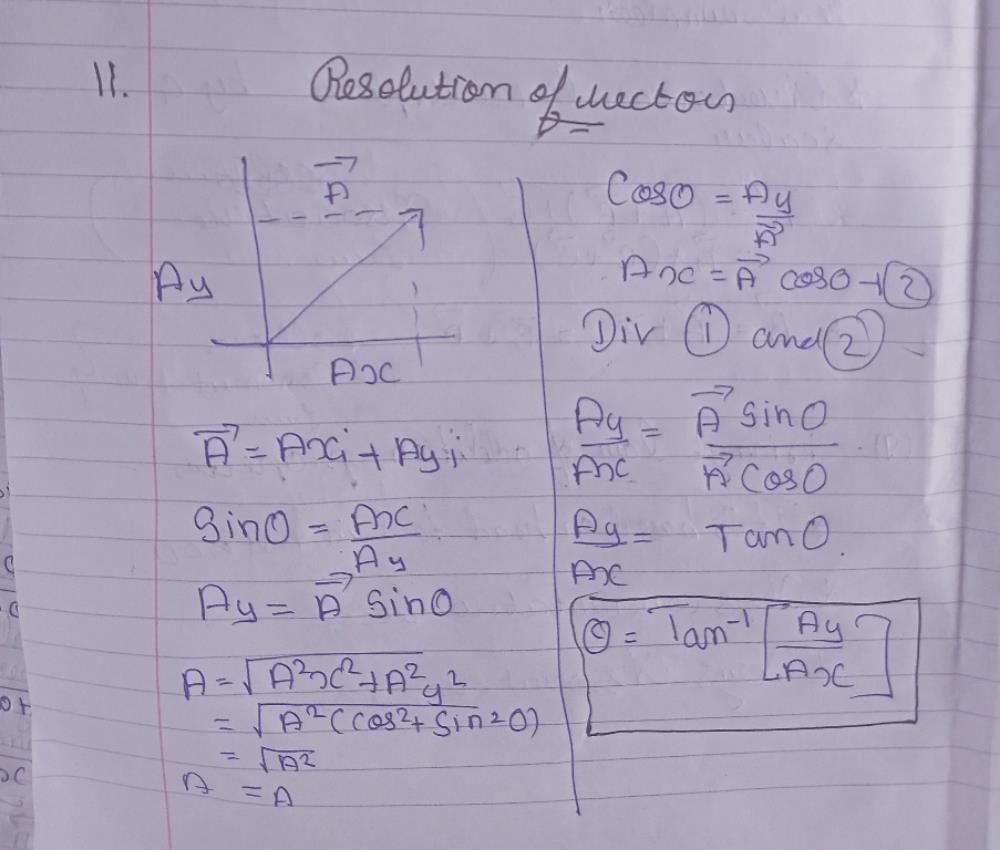Class 11 Exam > Class 11 Questions > what is mean by resolution Related: Resoluti...
Start Learning for Free
what is mean by resolution
?Most Upvoted Answer
what is mean by resolution Related: Resolution of Vectors into Compon...
Resolution of Vectors into Components refers to the process of breaking down a vector into its components along different axes or directions. This is an important concept in physics and engineering, as it allows us to analyze the behavior and motion of objects in different directions.
Resolution of Vectors into Components involves the following steps:
1. Identify the vector that needs to be resolved into components.
2. Choose the axes or directions along which the vector will be resolved. These axes should be perpendicular to each other.
3. Use trigonometry to calculate the magnitude and direction of the components of the vector along each axis.
For example, if we have a vector that represents the velocity of a car traveling at an angle of 30 degrees to the x-axis, we can resolve this vector into components along the x and y axes as follows:
1. The vector represents the hypotenuse of a right-angled triangle.
2. The x-component of the vector is the adjacent side of the triangle, and the y-component is the opposite side.
3. Using trigonometry, we can calculate the magnitude of the x-component as v cos 30, and the magnitude of the y-component as v sin 30, where v is the magnitude of the original vector.
Once we have resolved the vector into its components, we can analyze the behavior of the object along each axis separately. This can be useful in a range of applications, such as designing structures that can withstand forces in different directions, or predicting the motion of objects in different environments.
In summary, Resolution of Vectors into Components is an important concept in physics and engineering that involves breaking down a vector into its components along different axes or directions. This allows us to analyze the behavior and motion of objects in different directions, and can be useful in a range of applications.
Resolution of Vectors into Components involves the following steps:
1. Identify the vector that needs to be resolved into components.
2. Choose the axes or directions along which the vector will be resolved. These axes should be perpendicular to each other.
3. Use trigonometry to calculate the magnitude and direction of the components of the vector along each axis.
For example, if we have a vector that represents the velocity of a car traveling at an angle of 30 degrees to the x-axis, we can resolve this vector into components along the x and y axes as follows:
1. The vector represents the hypotenuse of a right-angled triangle.
2. The x-component of the vector is the adjacent side of the triangle, and the y-component is the opposite side.
3. Using trigonometry, we can calculate the magnitude of the x-component as v cos 30, and the magnitude of the y-component as v sin 30, where v is the magnitude of the original vector.
Once we have resolved the vector into its components, we can analyze the behavior of the object along each axis separately. This can be useful in a range of applications, such as designing structures that can withstand forces in different directions, or predicting the motion of objects in different environments.
In summary, Resolution of Vectors into Components is an important concept in physics and engineering that involves breaking down a vector into its components along different axes or directions. This allows us to analyze the behavior and motion of objects in different directions, and can be useful in a range of applications.
Community Answer
what is mean by resolution Related: Resolution of Vectors into Compon...


|
Explore Courses for Class 11 exam
|

|
Similar Class 11 Doubts
Question Description
what is mean by resolution Related: Resolution of Vectors into Components? for Class 11 2025 is part of Class 11 preparation. The Question and answers have been prepared according to the Class 11 exam syllabus. Information about what is mean by resolution Related: Resolution of Vectors into Components? covers all topics & solutions for Class 11 2025 Exam. Find important definitions, questions, meanings, examples, exercises and tests below for what is mean by resolution Related: Resolution of Vectors into Components?.
what is mean by resolution Related: Resolution of Vectors into Components? for Class 11 2025 is part of Class 11 preparation. The Question and answers have been prepared according to the Class 11 exam syllabus. Information about what is mean by resolution Related: Resolution of Vectors into Components? covers all topics & solutions for Class 11 2025 Exam. Find important definitions, questions, meanings, examples, exercises and tests below for what is mean by resolution Related: Resolution of Vectors into Components?.
Solutions for what is mean by resolution Related: Resolution of Vectors into Components? in English & in Hindi are available as part of our courses for Class 11.
Download more important topics, notes, lectures and mock test series for Class 11 Exam by signing up for free.
Here you can find the meaning of what is mean by resolution Related: Resolution of Vectors into Components? defined & explained in the simplest way possible. Besides giving the explanation of
what is mean by resolution Related: Resolution of Vectors into Components?, a detailed solution for what is mean by resolution Related: Resolution of Vectors into Components? has been provided alongside types of what is mean by resolution Related: Resolution of Vectors into Components? theory, EduRev gives you an
ample number of questions to practice what is mean by resolution Related: Resolution of Vectors into Components? tests, examples and also practice Class 11 tests.

|
Explore Courses for Class 11 exam
|

|
Signup to solve all Doubts
Signup to see your scores go up within 7 days! Learn & Practice with 1000+ FREE Notes, Videos & Tests.


























